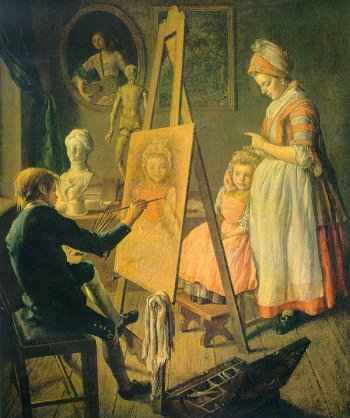
Oil on canvas, 67 x 55 cm. Tretiakov Gallery, Moscow.

 Ivan Firsov was a relatively unknown Russian painter of the eighteenth century; his works were even attributed to the famous classicist Losenko. He was born in 1733 and died after 1785. Little is known about his life and his art. In the 1760s, Catherine the Great sent Firsov to study in Paris at the Academy of Painting and Sculpture. Not surprisingly, Firsov's paintings seem to be inspired by the works of French painters more than by Russian. Historical sources mention that during his stay in Paris, Firsov lived at a hairdresser's home and perhaps made it a setting for his most famous painting, A Young Painter.
Ivan Firsov was a relatively unknown Russian painter of the eighteenth century; his works were even attributed to the famous classicist Losenko. He was born in 1733 and died after 1785. Little is known about his life and his art. In the 1760s, Catherine the Great sent Firsov to study in Paris at the Academy of Painting and Sculpture. Not surprisingly, Firsov's paintings seem to be inspired by the works of French painters more than by Russian. Historical sources mention that during his stay in Paris, Firsov lived at a hairdresser's home and perhaps made it a setting for his most famous painting, A Young Painter.
A Young Painter was purchased in 1890 by Pavel Tretyakov from a Moscow collector. "Among the few known genre pieces by eighteenth-century Russian painters, A Young Painter stands out both because of the vivid naturalness of the scene depicted, and because of the finesse and freshness of its brushwork" (Sokolova, 56). The image of the young painter could possibly allude to the beginnings of Firsov's art career, while the little girl and her mother could be based on the family of the hairdresser. However, it is more likely that the topic, a genre scene, was chosen because of the proliferation of similar scenes in the works of French painters of the time.
The positions and gestures of the people in the composition are informal, making the painting seem unrestrained and free, different than the majority of neoclassical works. In the composition, a young painter, sitting at the easel, is painting a portrait of a little girl, while her mother holds her still and seems to be calming or admonishing her. Looking at her extended finger, we can almost hear the mother saying "Hold still or your portrait will not be finished." The little girl sits on a stool, with her feet on a tiny bench, leaning against her mother and looking at the painter. While the mother is trying to persuade her daughter to sit still, the young artist is relaxed and comfortable, with his left foot resting on the cross-bar of the easel and supporting his left hand with a palette and brushes. "The characters' postures and gestures, so true to life and unaffected, betray the artist's keen powers of observation and fondness for the peaceful daily pursuit of ordinary people. It is this obvious affection that makes Firsov's modest and unsophisticated canvas so attractive" (Sokolova, 56).
A Yong Painter's appeal depends, to a great extent, on various interesting details. In the background, two paintings -- a carefully rendered oval portrait of a lady playing a guitar and a landscape with barely discernible trees -- provide a visual boundary and create depth. In the middle of the room, on a table, stands a human figure and a plaster-of-Paris bust, both essential tools of a young artist, used to train his hand in drawing. Several books and a piece of drawing paper lie on the table. The painter's tools -- the easel, the box with paints, the palette knife, even the brush-cleaning rag hanging on the easel -- are depicted with all the necessary details. The mother's and daughter's dresses are full and their creases and designs are carefully rendered. The bluish-green drapery pinned to the wall seems to soften the light and allows a natural glow to illuminate the room and accentuate the sculptured bust and the artist's head. The rendering of other details -- the buttons on the young painter's pants, the buckles on the shoes, the jewelry worn by the mother, and the knots and grain in the wooden floor demonstrate Firsov's technical excellence and prove that he has been unjustly neglected.
Since some critics noted in Firsov's work apparent influence of Chardin's " laboriously slow working methods" (Bird, 62), it should be interesting to compare this painting with the French master's works and to find the possible sources of Firsov's inspiration. A cursory look at Chardin's portrait of the painter Joseph Aved, shown at the Salon of 1737 as a Chemist in His Laboratory and later as A Philosopher Reading, reveals similarities in the color scheme (particularly the ochres, bluish greens, and oranges), in the slightly hazy background, and in the soft light illuminating the scene. Chardin's 1740 painting, The Diligent Mother, may provide another clue -- the mother in Firsov's work and the mother in Chardin's painting wear similar dresses with striped sleeves. [S.T. and A.B.]
[Sources: Bird, Sokolova.]